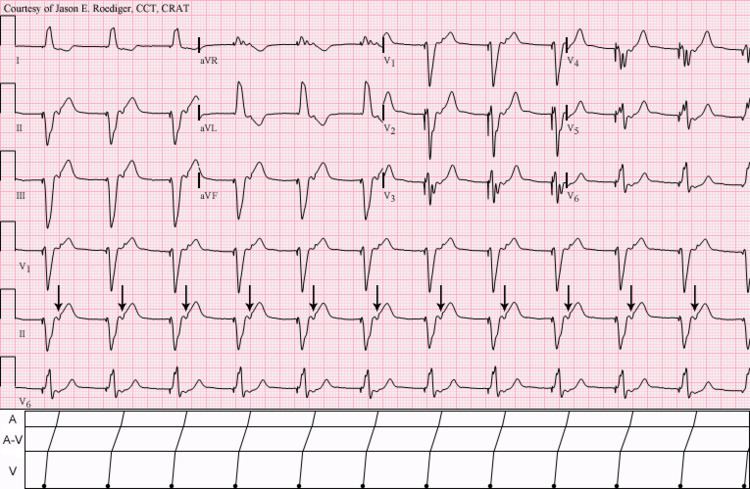 | ||
Pacemaker syndrome is a disease that represents the clinical consequences of suboptimal atrioventricular (AV) synchrony or AV dyssynchrony, regardless of the pacing mode, after pacemaker implantation. It is an iatrogenic disease—an adverse effect resulting from medical treatment—that is often underdiagnosed. In general, the symptoms of the syndrome are a combination of decreased cardiac output, loss of atrial contribution to ventricular filling, loss of total peripheral resistance response, and nonphysiologic pressure waves.
Contents
- Signs and symptoms
- Causes
- Risk factors
- Pathophysiology
- Loss of atrial contraction
- Cannon A waves
- Increased atrial pressure
- Increased production of natriuretic peptides
- VA conduction
- Prevention
- Diet
- Medication
- Medical Care
- Surgical Care
- Complications
- Epidemiology
- History
- References
Individuals with a low heart rate prior to pacemaker implantation are more at risk of developing pacemaker syndrome. Normally the first chamber of the heart (atrium) contracts as the second chamber (ventricle) is relaxed, allowing the ventricle to fill before it contracts and pumps blood out of the heart. When the timing between the two chambers goes out of synchronization, less blood is delivered on each beat. Patients who develop pacemaker syndrome may require adjustment of the pacemaker, or fitting of another lead to better coordinate the timing of atrial and ventricular contraction.
Signs and symptoms
No specific set of criteria has been developed for diagnosis of pacemaker syndrome. Most of the signs and symptoms of pacemaker syndrome are nonspecific, and many are prevalent in the elderly population at baseline. In the lab, pacemaker interrogation plays a crucial role in determining if the pacemaker mode had any contribution to symptoms.
Symptoms commonly documented in patients history, classified according to etiology:
In particular, the examiner should look for the following in the physical examination, as these are frequent findings at the time of admission:
Causes
The etiology is poorly understood. However several risk factors are associated with pacemaker syndrome.
Risk factors
Pathophysiology
The loss of physiologic timing of atrial and ventricular contractions, or sometimes called AV dyssynchrony, leads to different mechanisms of symptoms production. This altered ventricular contraction will decrease cardiac output, and in turn will lead to systemic hypotensive reflex response with varying symptoms.
Loss of atrial contraction
Inappropriate pacing in patients with decreased ventricular compliance, which may be caused by diseases such as hypertensive cardiomyopathy, hypertrophic cardiomyopathy, restrictive cardiomyopathy, and aging, can result in loss of atrial contraction and significantly reduces cardiac output. Because in such cases the atrias are required to provide 50% of cardiac output, which normally provides only 15% - 25% of cardiac output.
Cannon A waves
Atrial contraction against a closed tricuspid valve can cause pulsation in the neck and abdomen, headache, cough, and jaw pain.
Increased atrial pressure
Ventricular pacing is associated with elevated right and left atrial pressures, as well as elevated pulmonary venous and pulmonary arterial pressures, which can lead to symptomatic pulmonary and hepatic congestion.
Increased production of natriuretic peptides
Patients with pacemaker syndrome exhibit increased plasma levels of ANP. That's due to increase in left atrial pressure and left ventricular filling pressure, which is due to decreased cardiac output caused by dyssynchrony in atrial and ventricular contraction. ANP and BNP are potent arterial and venous vasodilators that can override carotid and aortic baroreceptor reflexes attempting to compensate for decreased blood pressure. Usually patients with cannon a waves have higher plasma levels of ANP than those without cannon a waves.
VA conduction
A major cause of AV dyssynchrony is VA conduction. VA conduction, sometimes referred to as retrograde conduction, leads to delayed, nonphysiologic timing of atrial contraction in relation to ventricular contraction. Nevertheless, many conditions other than VA conduction promote AV dyssynchrony.
This will further decrease blood pressure, and secondary increase in ANP and BNP.
Prevention
At the time of pacemaker implantation, AV synchrony should be optimized to prevent the occurrence of pacemaker syndrome. Where patients with optimized AV synchrony have shown great results of implantation and very low incidence of pacemaker syndrome than those with suboptimal AV synchronization.
Diet
Diet alone cannot treat pacemaker syndrome, but an appropriate diet to the patient, in addition to the other treatment regimens mentioned, can improve the patient's symptoms. Several cases mentioned below:
Medication
No specific drugs are used to treat pacemaker syndrome directly because treatment consists of upgrading or reprogramming the pacemaker.
Medical Care
Surgical Care
Sometimes surgical intervention is needed. After consulting an electrophysiologist, possibly an additional pacemaker lead placement is needed, which eventually relieve some of the symptoms.
Complications
Studies have shown that patients with Pacemaker syndrome and/or with sick sinus syndrome are at higher risk of developing fatal complications that calls for the patients to be carefully monitored in the ICU. Complications include atrial fibrillation, thrombo-embolic events, and heart failure.
Epidemiology
The reported incidence of pacemaker syndrome has ranged from 2% to 83%. The wide range of reported incidence is likely attributable to two factors which are the criteria used to define pacemaker syndrome and the therapy used to resolve that diagnosis.
History
Pacemaker syndrome was first described in 1969 by Mitsui et al. as a collection of symptoms associated with right ventricular pacing. The name pacemaker syndrome was first coined by Erbel in 1979. Since its first discovery, there have been many definitions of pacemaker syndrome, and the understanding of the cause of pacemaker syndrome is still under investigation. In a general sense, pacemaker syndrome can be defined as the symptoms associated with right ventricular pacing relieved with the return of A-V and V-V synchrony.
